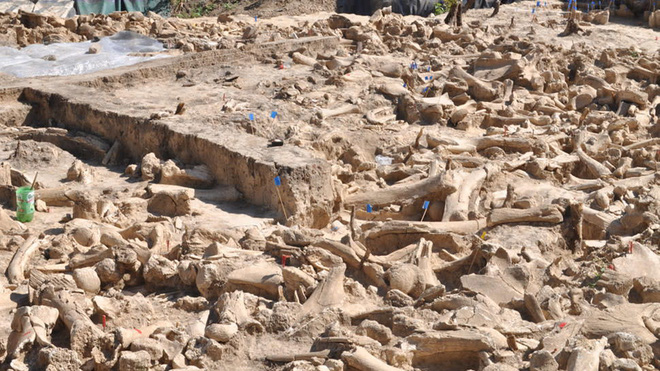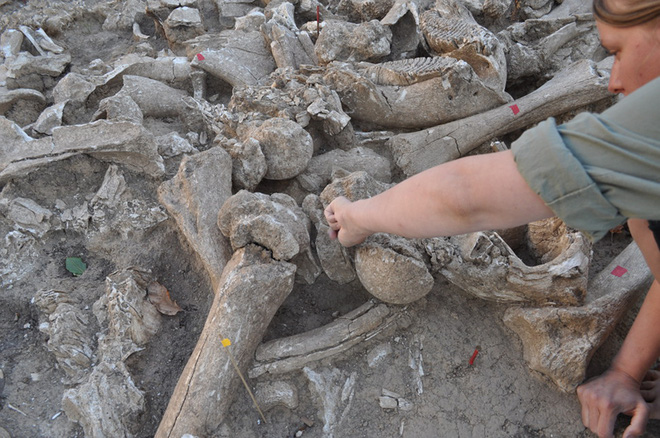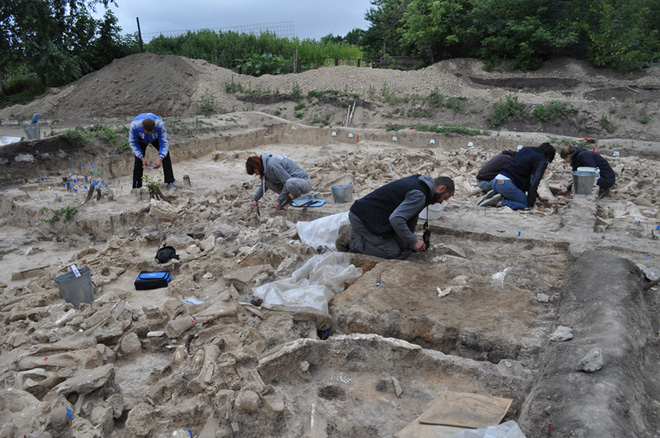The largest mammoth structure ever found in Russia, shows that prehistoric humans are probably wiser than we thought.
Recently, an anomaly large architectural area erected by mammoth bone fossils has been unearthed in the area of code Kostenki 11, Russia. This area is about 12.5 meters wide, located next to the Don River in the city of Voronezh. According to the scientists who study here, the dates of these skeletons date back to about 25,000 years, and this is probably the oldest mammoth architecture excavated by humans.
"Explaining the existence of these structures, besides being a residence for humans, there is another possibility of serving a certain religious goal of the ancients," Alexander Pryor , a member of the research team at Exeter University said.

"However, what the goal of belief is, our archaeologists have not enough evidence to conclude."
This is not the first time ancient archaeologists have found mammoth skeletons in the Kotenski area 11. Around the 1950s and 1960s, Soviet scientists unearthed two Other architecture, also built entirely of mammoth bones.
The fact that people in the Pleistocene period had devoted themselves to building such structures surprised many archaeologists. The reason is that ancient hunters were often present, and the construction of fixed structures that researchers thought was not in the minds of humans at that time.

"Identifying the origins of these skeletons is hard work, because they come from at least 60 different mammoths. Besides, explaining how these structures were created is also very difficult." causing a lot of headaches, because the mammoth's fresh bones are heavy - so bringing them from place to place is a lot of work. "
Further analysis of the fossils excavated in the area helped scientists find traces of coal, burnt bone fragments, along with some debris of stone tools. All of these specimens led scientists to hypothesize that this architecture was built by the Pleistocene people to take refuge in the cold weather of the ice age. Besides, this place can also be a place where people store food.

"If these mammoth skeletons were the result of a hunt, it would mean they would have a large amount of meat and need a place to store them. Therefore, there is a high possibility These architectures were built as a food storage for people at that time. " Pryor said. The next phase of the archeology at Kotenski 11 will also focus on analyzing the role of this architecture for the Pleistocene people.
However, the nature of these skeletal structures is in some ways unsuitable for long-term human shelter. On the one hand, the mammoth skeletons when they are new will smell very, and can absolutely attract other dangerous predators like foxes or wolves. On the other hand, the amount of debris of the stone tools here is much smaller than in other areas, which shows that the activities at this site are also much less.

But no matter what the purpose of this architecture is, it shows that the hunters of the Pleistocene period were probably wiser than we thought. Instead of just following the trail of animals for hunting and gathering, people in this period knew how to build buildings for their own purposes - even if it were to stay. , to make a storehouse, to serve a religion, or for whatever purpose. And hopefully, further research will give us an answer on the purpose of building this architecture of the Pleistocene.
According to Gizmodo
You should read it
- Tracing the stolen truck, discovering the second-century ancient coffin under the olive tree
- Many thousands of years old stone artifacts were found in the North Iran cemetery
- Italian archeology finds the oldest set of dentures in the world
- There are hundreds of caves in Nottingham not yet discovered
- The 4000-year-old weapon, lunch box discovered in Switzerland
- Find more than 40 mysterious shipwrecks under the Black Sea
- Chinese archeology seeks to source human history in Africa
- Signs of ancient wildlife discovered in South Aswan
May be interested
- Humans transmit more viruses to animals than they transmit to humans
 a recent study shows that the spread of viruses is not only from animals to humans, humans also spread many diseases to animals.
a recent study shows that the spread of viruses is not only from animals to humans, humans also spread many diseases to animals. - Did you know: people and pigs have the same skin structure, human nervous system and round worms are the same ...
 do you know the human nervous system and the same roundworm, the equal number of bones in mice and humans, the brains of dolphins are like humans, and even more wrinkles ...
do you know the human nervous system and the same roundworm, the equal number of bones in mice and humans, the brains of dolphins are like humans, and even more wrinkles ... - 10 prehistoric giant animals are easily confused with dinosaurs
 if you just look through the picture, you will certainly confuse the animals below as one of prehistoric dinosaurs.
if you just look through the picture, you will certainly confuse the animals below as one of prehistoric dinosaurs. - In terms of size, where does the human being stand for a dinosaur?
 taking the size of an average man 168cm high, 46cm wide to compare with prehistoric dinosaurs such as brachiosaurus or tyrannical dinosaurs, humans are really small. but for many other small dinosaurs such as velociraptor, troodon ... our species is far superior in size.
taking the size of an average man 168cm high, 46cm wide to compare with prehistoric dinosaurs such as brachiosaurus or tyrannical dinosaurs, humans are really small. but for many other small dinosaurs such as velociraptor, troodon ... our species is far superior in size. - 14 interesting facts about Russia
 russia is bigger than a planet, used to tax people who grew beards, had up to 9 time zones... these are interesting things about russia that surprise many people.
russia is bigger than a planet, used to tax people who grew beards, had up to 9 time zones... these are interesting things about russia that surprise many people. - Location 10 Prehistoric Fish Bone in Fisch Roblox
 during the archaeological hunt event, nph added a new quest revolving around dr. finneus, who asks you to collect 10 prehistoric fish bones scattered around the map. so if you want to know where 10 prehistoric fish bones are in fisch and how to collect them, check out the guide below.
during the archaeological hunt event, nph added a new quest revolving around dr. finneus, who asks you to collect 10 prehistoric fish bones scattered around the map. so if you want to know where 10 prehistoric fish bones are in fisch and how to collect them, check out the guide below. - Prehistoric women were more suited to hunting than men?
 according to some new research, prehistoric women not only regularly participated in hunting, but they also had more favorable physiology for this activity than men.
according to some new research, prehistoric women not only regularly participated in hunting, but they also had more favorable physiology for this activity than men. - Your bone structure also affects appetite
 a new study shows that the human skeleton is not only a muscle support structure, but also other tissues that affect appetite.
a new study shows that the human skeleton is not only a muscle support structure, but also other tissues that affect appetite. - 'Russia has no winter this year'
 this is the historic hot winter of russia, when the temperature reached 6.3 degrees celsius.
this is the historic hot winter of russia, when the temperature reached 6.3 degrees celsius. - What is Data Structure?
 data structure is a way of storing, organized and systematic data organization so that data can be used effectively.
data structure is a way of storing, organized and systematic data organization so that data can be used effectively.










 Louis Vuitton purchased 40 million masks of COVID-19 for France
Louis Vuitton purchased 40 million masks of COVID-19 for France Scientists find the true cause of the giant animal extinction in Australia
Scientists find the true cause of the giant animal extinction in Australia Tools that turn plastic bottles into ropes
Tools that turn plastic bottles into ropes Wind and solar are becoming cheaper than traditional coal power plants
Wind and solar are becoming cheaper than traditional coal power plants Discovered the intact skull of 'Magical Chicken': the ancestor of today's birds, living with the dinosaurs 67 million years ago
Discovered the intact skull of 'Magical Chicken': the ancestor of today's birds, living with the dinosaurs 67 million years ago People living in polluted atmosphere are vulnerable to Covid-19
People living in polluted atmosphere are vulnerable to Covid-19